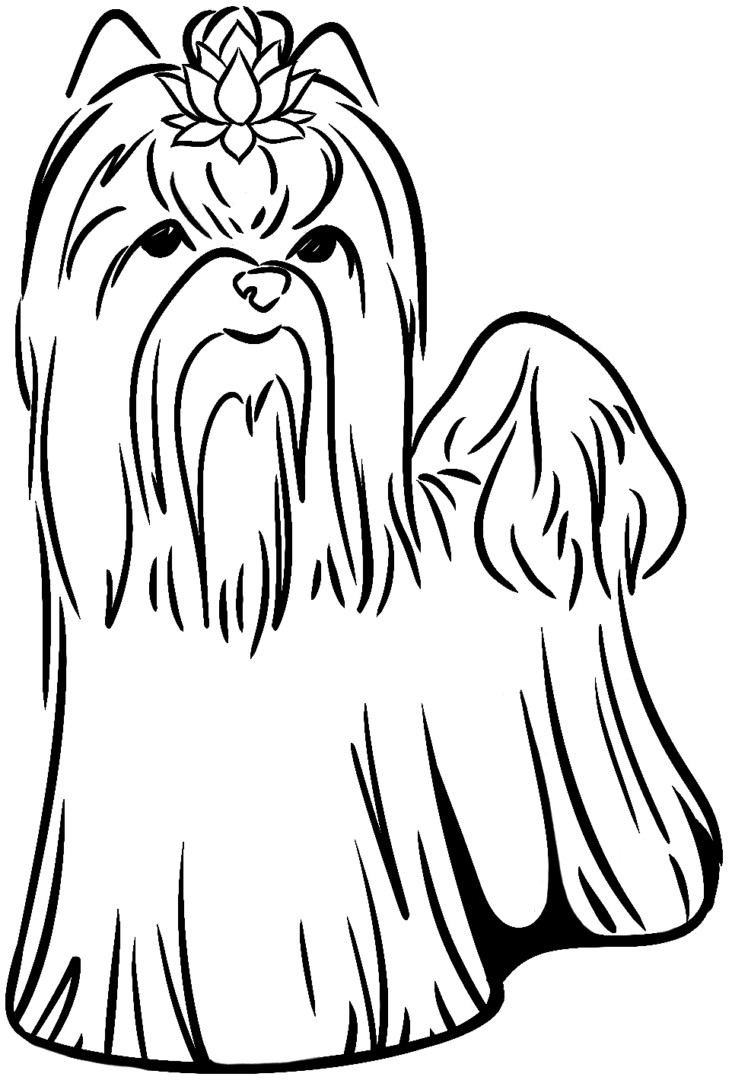Genetics
Whats in a Color?
By: Chris Davis
Click Here to See Pictures Of All Biewer & Yorkshire Terrier Colors
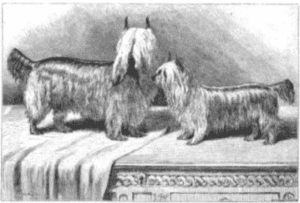
History
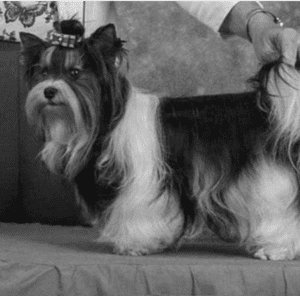
The Yorkshire Terrier was developed during the mid-1800s in the northern English counties of Yorkshire and Lancashire. It became a fashionable lapdog for proper English ladies in late Victorian times, but its beginnings were distinctly working-class.
The breed is said to be the creation of weavers from Scotland who migrated to the English north country and brought their Scottish terriers with them. (We pause here to make the distinction between Scottish terriers, that is, terriers of Scotland, and the particular breed designated as Scottish Terriers.) Several breeds of now-extinct Scottish terriers are a part of the Yorkie’s genetic mix, along with such still-extant terriers as the Skye and Dandie Dinmont. One historical source suggests the addition of Malteseblood.
The Scots weavers were proud of their tough little terriers, bred small enough to squeeze into the nooks and crannies of textile mills in pursuit of rodents. Jokes were made about the Yorkie’s long, silky coat, inferring that its finely textured hair was a product of the looms. The Yorkie’s home region was a center of mining as well as textile making, and many Yorkies were employed in coal mines as exterminators.
The turning point in the breed’s history came in 1886, when the Kennel Club (England) granted the Yorkie recognition. With this splash of publicity, the Yorkie became fashionable as a ladies’ companion. And, as the Yorkie’s popularity among the fashionable increased, its size decreased to better meet its new job description: adorable, amusing companion sitting in the lap of luxury.
Yorkies were first seen in America in the 1870s, and the AKC recorded its first Yorkie, a female named Belle, in 1885.
Inheritance
It would probably be wise at this point to say a few words on inheritance so that when we start talk more in depth about the colors, the vehicle for passing on various genes is understood. This is an extremely simplified explanation simply for the purposes of our discussion.
Recessive
If a genetic trait is recessive, a dog needs to inherit two copies of the gene for the trait to be expressed, or seen. Unless it was created by a mutation which has been seen to happen. This is how all different colors first appeared, the same thing goes for eye color in humans and animals as well. Generally, both parents have to be carriers of a recessive trait in order for an offspring to express or show that trait. If both parents are carriers, there is a 25% chance with each offspring to show the recessive trait.
Double Recessive
If a dog shows a color that is known to be recessive, then they have inherited the gene from both parents making it double recessive and if that dog is bred to another that shows the same recessive color then that color will always “breed true”, meaning they will only produce puppies of that color. So Chocolate & Tan is double recessive and bred to another Chocolate & Tan will only have Chocolate colored Puppies because the only genes the parent have to contribute are the little b's which means brown. (See table below.) Red font indicates mother’s genetic contribution and blue, the father’s. The recessive genes will always “mask” or override dominant genes when inherited from both parents.
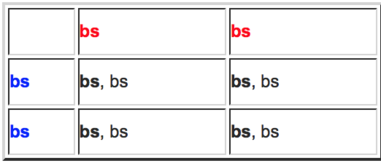
Dominant
If a genetic trait is dominant, a dog only needs to inherit one copy of the gene for the trait to be expressed. The dominat gene can be “masked” by the doubling of recessive genes. For example, all Mini Schnauzers carry the genes to be Salt & Pepper but if they inherit the genes to be White from both parents, the Salt & Pepper is covered or “hidden” and the dog’s coat is White.
Simple Dominant
This means that if one gene is present it will manifest fully, and if two are present it manifests no differently than with one. As an example take a S&P male with no White gene being carried bred to a White female. Since he has no White gene and she had a masked S&P gene, the resulting puppies will all be S&P (but will also all carry for the White gene), provided no other matching recessive genes are carried and passed by the parents.
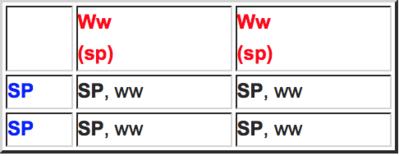
Dominant Direct Inheritance
Genes that are dominant direct inheritance cannot be “hidden” or “carried”. They must be directly inherited from a parent. They cannot “skip” a generation. An example is a puppy that is “One Color” (see explanation paragraph and color table in section on color below), one of the parents must also be “One Color” (not necessarily the same base color).
Homozygous
Homozygous means that they have doubled up dominant genes thus ensuring they can produce no other color. Example is homozygous “One Color” Black, meaning all puppies from this dog will be Black. One cannot ensure “One Color” Chocolate because brown-base is itself recessive, thus requiring the brown-base recessive gene from both parents, recessive genes cannot be homozygous. Further, in order to be homozygous, both of the homozygous dog’s parents have to be that color, but the flipside is not true…just because both of a dog’s parents are Black, it does not necessarily make the dog homozygous. The exception to this is if the dog’s parents are both homozygous themselves, then all their offspring must be homozygous.
Heterozygous
Heterozygous is the opposite of homozygous. It means that the dominant gene is not doubled up and the dog is carrying “hidden” or recessive gene(s), which can be expressed in the proper mating.
To further complicate matters, the various color genes, called alleles are carried on a DNA strand in specific spots called Locus (plural loci) like notches on a stick. So this means that one dog can have several different “notches” on their DNA stick and it is not just a matter of whether they have this gene and not that one but also how the different genes affect one another. For example, let’s say we have a Black dog that is heterozygous. “K” represents the color black genetically on the DNA strand so we will use that as well, Capital “K” means Black and little “k” means not black. So our Heterozygous Black dog is Kk at the locus or “notch” for black. Bred to another heterozygous Black, the following combinations are possible:

So obviously the possible combinations are 25% homozygous Black, 50% heterozygous Black and 25% not Black. So if the dog is not Black, what color is it? This is where the other “notches” come into play. The dog will have other genes to determine what color they will be when they are not another color. It appears however, as though all Mini Schnauzers carry for Salt & Pepper and that it can be masked or hidden by other genes and when the other genes fail to be expressed, then the S&P gene fulfills the need.
At this point let’s leave this subject where it stands and move on to the colors themselves.
Colors
So now let’s explore the various colors we find in the Biewer & Yorkshire Terriers. Firstly, for the purposes of clarity, let’s describe the genes a little differently for the purposes of this discussion. A dog with a solid, one-color coat (ie. a solid black), we will call a “one color”, a dog with a 2 color coat, (ie. Black and Tan) we will refer to as a “bi-color” and finally , Parti colors or Biewers will be discussed later and referred to as parti.
To begin with, it first needs to be understood that there are 2 base colors, brown (also called chocolate and liver) and black (what is most commonly seen) . These are easily distinguished by the color of the nose, pads and skin. Within each of these 2 base colors there are the 4 genetic patterns as we outlined in the previous paragraph. Please see the table below to better understand how these are displayed.
Genetic Pattern
Base Color – Black, the “default” or dominant base color, any 2 dogs bred together that do not carry or pass on the brown-base will always pass on the black-base, which is why it is the most common base color seen.
Base Color – Brown, recessive to the black-base requiring both parents to pass the gene to the offspring to show this color. This also means 2 brown-based dogs bred together will only produce brown based offspring. See ‘double recessive’, above.
One Color Dominant Direct Inheritance

The coat color of the black-based one color reflects the skin color making the coat color black. While there are actually many genes responsible for the “shade” of black, in this section we are only addressing the gene which makes the dog genetically “one color”, in this case black.


Once again the coat color reflects the skin color and makes this “one color” a chocolate color, also called liver. The shade can once again vary but the gene responsible for making this dog genetically “one color” is the same as in the black.
Bi-Color

This is the distinctly two-toned Black & Tan.

Chocolate & Tan, this is the bi-color gene as displayed within the context of the brow base. The “tan” points can range from a creamy, almost white color to a deeper nearly as dark as the chocolate of the main body color.
Base Colors
There are 2 base colors, Black "Is Dominant" and Brown "Is Recessive". The base color of the dogs is always reflected in the color of the nose and pads. These base colors have been in existence since the beginning of the breed and have been well documented, at least in the beginning. The claim that the Brown base is a “new” color and therefore not purebred is inaccurate. As it is recessive, it is possible to pass the gene on for generation after generation without it showing up and further, the very, very dark Brown based, One Color, Chocolate dogs can look almost Black and could easily be accidentally misidentified and registered as such, further continuing the genetic line. It has also been proven that there have been many breeders who have “disposed of” or purposefully misidentified the coloring of the “differently” colored dogs to preserve their “integrity” among the circles they turn in.
To begin with, it first needs to be understood that there are 2 base colors, brown (also called chocolate and liver) and black (what is most commonly seen) . These are easily distinguished by the color of the nose, pads and skin. Within each of these 2 base colors there are the 4 genetic patterns as we outlined in the previous paragraph. Please see the table below to better understand how these are displayed.
One Color
(Dominant Direct Inheritance) Puppies with the One Color gene will always be the color of their base color so their genetic color will always be the same as their nose/pads color. Because there are more genes involved with shade and thus color is not simply determined by the single gene, a One Color gene dog can look very different from another dog of the same One Color gene. There can be genes which determine that a dog fades and these genes will also control to what degree a dog fades, where they fade (full body, beard only, legs only) and what color they will fade out too.
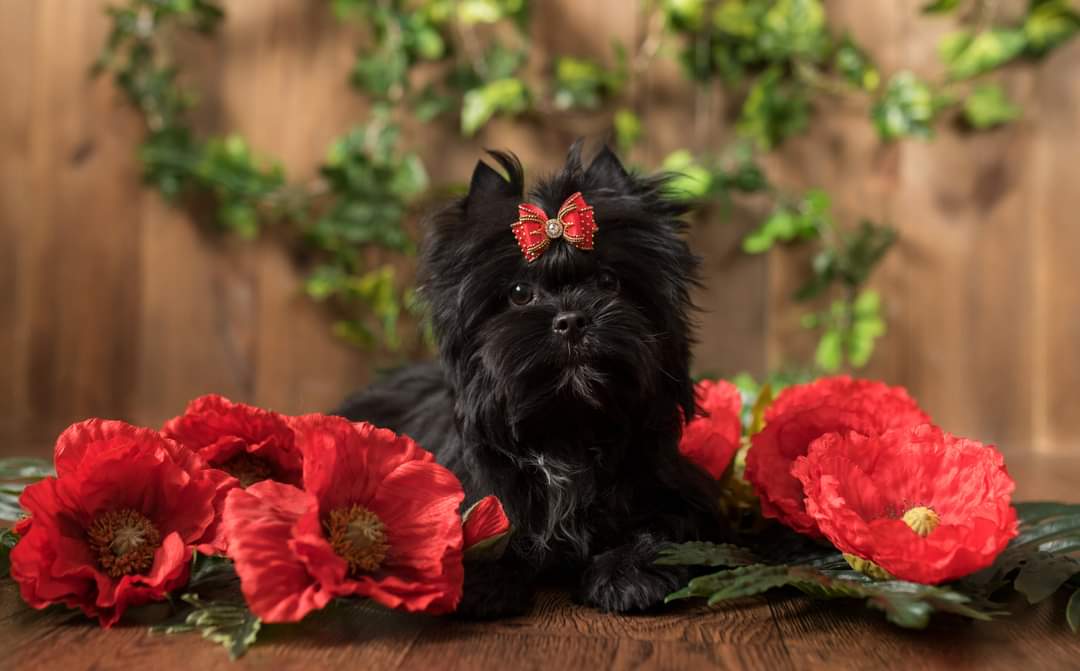

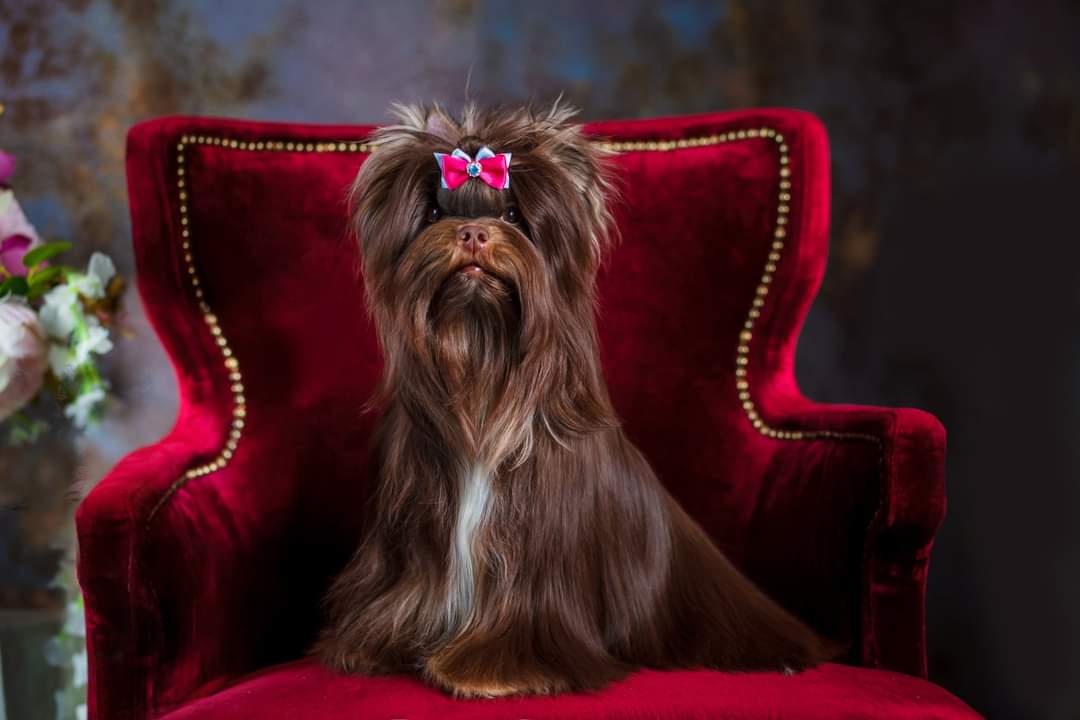
It should be noted that the genes responsible for fading often don’t start to affect coat color until some time after birth and how quickly or even if a dog fades cannot be determined at birth or even necessarily by 8 weeks. Also there was a time period when in Germany the only registerable Black Mini Schnauzers had to both have Black parents, this resulted in Homozygous Black dogs. Some of these were later imported into North America and are responsible for a large infusion of Black into the lines here.
Bi-Color

(Recessive) Chocolate & Tan

Black & Tan
The Bi-Color gene is what makes a Black & Tan or a Chocolate & Tan. Once again other genes are responsible for how dark or light the points and body appear and what, if any fading occurs.
Parti-Color Biewer's (Recessive)
It is now the time to address the Parti–color or spotting gene. separate from the other color genes since it can be displayed simultaneously with them and is a “pattern” gene also known as a “broken color” gene. There have been recorded Part-Colored Yorkshire Terriers in this country as far back as the 1980’s. The Parti coloring can be seen as big “saddles” of color on a white background or as a “splattering” of colored freckles on the white background, or more commonly, both. It needs to be said that parti or spotted "aka" Biewer Terriers came from the Yorkshire Terrier. So technically they are Yorkies, AKC made their own class and breed separate from yorkies in 2021.
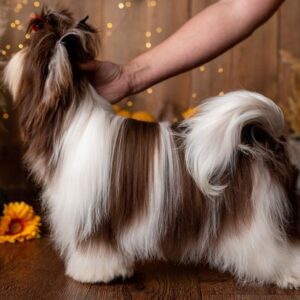
"Biro" Recessive Chocolate Biewer Terrier

Black Tan & White Biewer Terrier
Gene Combinations
All Biewer & Yorkshire Terrier Colors have a combination of these genes we have discussed. Each one has a Base color gene, a Coat pattern gene and an optional Parti pattern gene. Whether these are displayed or not sometimes depends on whether the gene is “turned” on or off. Like in the case of Black, as a dominant gene it is either inherited as Black or Not Black. With the recessive genes it is a matter whether or not two matching gene pairs are inherited, one from each parent.
In Conclusion
I hope this helps clear up some of the confusion regarding the colors. I also want to be sure to make it clear that to say that the non-standard colors are “not recognized” by the AKC is not accurate. They most certainly are recognized otherwise they would not be able to be registered as purebred Biewer & Yorkshire Terriers. They are register-able and recognized, simply not able to be shown in the conformation classes. They can still participate in Agility, Obedience and Search and Rescue. Just so that is clear to all. Thank you for taking the time to read this. I hope it was informative.
For more information CLICK HERE to visit Animal Genetics
